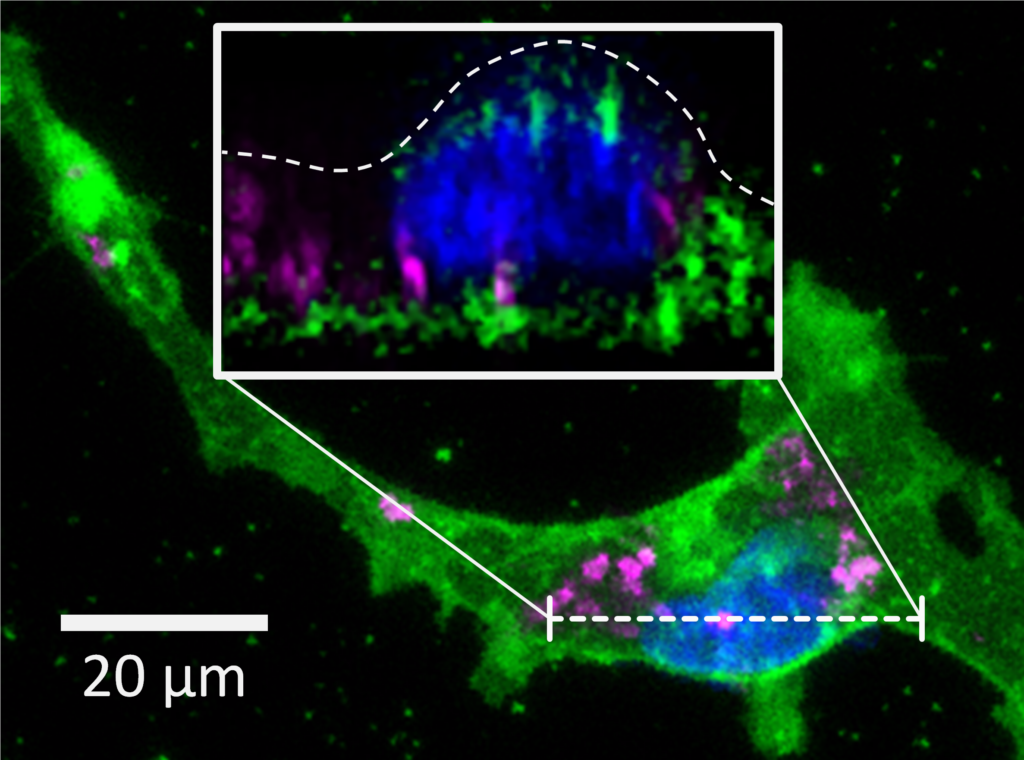This work focuses on the study of the intrinsic cytotoxicity of magnetic particles, developed in our laboratory for the application of local forces at the cellular level. More precisely, we were interested in the effect of the rigidity of the cellular growth substrate on the response induced by the presence of particles.
Top-view confocal microscopy image of vortex particles internalized by a U87 cell grown on soft hydrogel substrate. Insert: zoom of a side-view image of the cell, showing particles dispersed within the cell body – without crossing the nucleus membrane. Cell membrane appears in green, cell nucleus in blue, and vortex particles in magenta.
The study of the cytotoxicity of nanoparticles is a major challenge in biomedical research. This is true with regard to the environmental risks that they may represent, but also in the context of the development of new therapies using nanoparticles as drug vectors or as therapeutic agents. SPINTEC’s Biology and Health team has been working for several years on the use of magnetic particles to generate, at the cell level, forces capable of modifying their physiology. The forces in question, of the order of a few nano newton, result from the vibration of particles by application of variable magnetic fields. Among the notable results obtained with this technique are the destruction of cancer cells or the stimulation of insulin production in pancreatic cells.
In this paper, we look at the intrinsic cytotoxicity of such particles. More specifically, as the cytotoxicity of nanoparticles is routinely assessed with cells grown in plastic culture plates that are a million times stiffer than most of the human tissues, we question whether nanoparticles cytotoxicity is sensitive to the stiffness of the extracellular environment. To this end, we compare the metabolic activity, proliferation, death rate, as well as the motility of a 3T3 fibroblast and a U87 glioblastoma cancer cell line exposed to magnetic particles. More precisely, we compare cells physiological reaction when they are grown on a rigid glass substrate, or on a soft hydrogel substrate whose mechanical properties are close to physiology.
Our main result is that cells grown on soft substrates take up more microdiscs, which results in greater toxic effects, but also that toxicity at similar particle load is more pronounced on soft substrates especially at large concentration of nanoparticles. These results suggest that both microdiscs uptake and their intracellular processing differ between soft and rigid substrates.
This observation should be compared with the large impact the stiffness of the extracellular matrix has on basic cellular responses such as cell metabolism, which suggests that in vitro cytotoxicity assessment of nanomaterials may gain relevance by considering growing the cells on softer substrates, whose stiffness is representative of the tissue of interest. Interestingly, our study also shows that the evaluation of the sensitivity of particles cytotoxicity to the stiffness of the extracellular environment cannot be restricted to the sole cell metabolic activity, as we have observed various impact on the cell behavior, including cell proliferation, death, migration and endocytosis, which all contribute to the metabolic activity.
Team: HEALTH and BIOLOGY
Collaboration:LTM/CNRS
Funding: UGA IRGA MagCell Project
Further reading: Substrate softness increases magnetic microdiscs induced cytotoxicity, A. Visonà, S. Cavalaglio, S. Labau, S. Soulan, H. Joisten, F. Berger, B. Dieny, R. Morel, and A. Nicolas, Nanoscale Advances (2024). Open access: hal-04788344
Contact at Spintec: Robert MOREL

